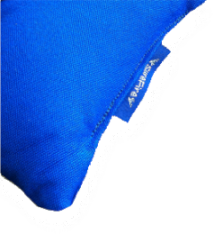

Surefire bags are special. Although they include some new materials like Plexicorn™, the real difference is in the construction techniques. Surefire bags are designed for strength and consistency. Great effort is expended so that each bag is identical to others in the set, and so the bags you buy today are the same as the bags you buy months down the line. Every step of the construction process focuses on this goal.
Surefire bags use imported duck cloth that is both stronger and more pliable than what's generally available locally. It feels less stiff when new. The thread is carefully selected premium bonded UV protected upholstery thread with twice the tensile strength required. Corn is about the same wherever you get it. But each batch and season brings slight natural variations in density. Surefire bags take an extra step to density balance the corn to improve consistency - a step that might be unique to Surefire. Materials matter, but the construction is the real key to great bags.
Cutting the fabric properly is crucial. We use special equipment to cut the cloth in a way that results in extreme dimensional consistency. The equipment costs a bit more and it takes a bit more time than merely slicing away with a ruler and rotary blade, but every tiny difference in the dimensions affects the volume of the bags, a bit bigger or smaller and the bag ends up a bit more or less bulky.
Constructing the pouch that will become the bag is the next key step. Surefire bags are stitched inside-out leaving an opening only large enough to fill the bag. When the bags are later inverted, all of the critical seams are hidden from the harsh environment where sun, water, and abrasion can accelerate aging and weakening. This method requires some specialized instruments and a little more effort, but we believe it results in a better, stronger, more balanced bag.
Internal seams are triple-stitched. Triple-stitching alone doesn't necessarily make a bag any stronger. The idea is not to use more threads to strengthen the stitch. That could be accomplished by a heavier thread. Nor is the idea to have a back-up stitch in case the first fails. Instead, double-stitching helps strengthen the weakest part of the fabric, the edges. Strong internal seams require the proper stitch type, stitch lengths, pattern combinations, seam allowance, and spacing, most of which depend on the fabric.
Finally Surefire bags make use of a little trick that is apparently not well known, one that isn't apparent elsewhere in cornhole bag-making. It takes advantage of basic understanding of how woven fabric is made. With one simple but non-obvious change in technique, extra strength is added to every bag, up to 20%! Everyone should know this, but sadly they don't, so we'll keep it to ourselves. They can consult a seamstress or materials engineer if they care to.
We fill each bag to a precisely measured weight within a 1/20th of an ounce in accuracy (or a gram in our pro-style bags). That's the equivalent of about three kernels of corn. Measuring every bag is tedious and requires more special equipment, but the alternative of simply using a premeasured approximate volume results in less consistent bags.
After the bags are filled, the open edge is sealed with an additional seam. We use a heavy-duty machine stitch that extends across a partial portion of the side of the bag and is protected from abrasion by the surounding fabric. Because the fabric is quadruple-folded under this seam, it tends to be the strongest part of the bag, which is a bit counter-intuitive. Recall that the strength of the fabric is more important than the seam thread. The one important aspect of this seam is that it not unravel since it is the only exposed seam on the bag and will be rubbed, scraped, dragged, and handled. To prevent unraveling, the ends of this seam are over-extended and double-backstitched.
Last but not least, Surefire bags are inspected throughout the process to catch any defects. If any seam wanders too close to an edge, crosses another where it should not, breaks, or drops stitches, it needs to be re-enforced or discarded. Seam allowances need to be adequate and even. Fabric needs to align correctly before and after stitching. Fabric cannot contain weak areas or defective threads. And no threads can be loose. We've noticed over the years that well-made bags almost never fail unless they are mistreated. Every bag that breaks prematurely is caused by a manufacturing or material defect. And almost all of those can be avoided by careful inspection during construction.